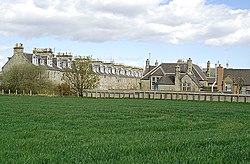Guardbridge (Scots: Gairbrig)[2] is a village in the north-east of Fife, on the east coast of Scotland. It is approximately 3 miles (5 km) north-west of St Andrews, and is situated on the estuary of the River Eden, at the junction of the A91 road between St Andrews and Stirling and the A919/A914 road between Leuchars and the Tay Road Bridge.
Guardbridge
| |
|---|---|
 | |
Location within Fife | |
| Population | 840 (2022)[1] |
| OS grid reference | NO466189 |
| Council area | |
| Lieutenancy area | |
| Country | Scotland |
| Sovereign state | United Kingdom |
| Post town | Kirkcaldy |
| Postcode district | KY16 |
| Dialling code | 01334 |
| Police | Scotland |
| Fire | Scottish |
| Ambulance | Scottish |
| UK Parliament | |
| Scottish Parliament | |
Guardbridge has a number of local amenities including a school, general store, garages, hotel, takeaway food shop, hairdresser, furniture maker, and bowling and fishing clubs. The village has also become a very popular dormitory settlement due to its close proximity to St Andrews and Dundee.
History
editThe village takes its name from the 15th-century six-arched bridge built by Bishop Henry Wardlaw,[3] who founded the University of St Andrews. Some have said the bridge was built to assist pilgrims en route to St Andrews; however, its purpose was to provide safe access for students to ensure the success of Wardlaw's university.[4]
Though the first element of the name is anglicized as 'Guard', the origin of the name has never been satisfactorily explained. As alternatives are less credible, the theory that this may come from "gare", the French term for statio, an assembly point for pilgrims, retains some credence in academic sources.[2] Others cast doubt on such usage of "gare" before the 18th century. Alternative theories include the Scots words "gair", meaning muddy,[4] or, though unlikely, "gerr", meaning clumsy or awkward.[2] The bridge is a Category A listed building.[5]
St Andrews was one of the most important pilgrimage centres in Europe. Hostels were available every 6 miles along the pilgrim trail, with the last one located at Guardbridge. There, up to 600 pilgrims were provided with dormitories, a refectory and a church. From that point, the Augustinians regulated the numbers travelling into the holy city of St Andrews. The average stay in the town was three months.[6]
In 1852, the north-east Fife railway line was extended to St Andrews and a viaduct was built over the Eden. This St Andrews Railway was closed in 1969, not as part of the Beeching cuts, as is commonly supposed, but by British Rail. The viaduct was demolished, but its supporting piers are still visible in the river.
In 1873 William Haig and two of his sons formed the Guardbridge Paper Company. This was to find a more profitable use for their Seggie whisky distillery, which had been established there since 1810.[7] The mill went into production in 1874. As the mill developed, the village grew around it, with new housing and roads to attract and accommodate workers. Before the First World War the labour force was over 400 and reached a peak of 620 in the late 1950s.
The paper mill was previously the main local industry and was operated by Curtis Fine Papers. On 24 July 2008 the mill went into receivership and 180 workers were made redundant.[8][9] Many locals were employed elsewhere in Fife, Dundee, Edinburgh or even further afield. The building which housed the mill is now Eden Brewery.
Notable residents
edit- David Finlay, recipient of the Victoria Cross
References
edit- ^ "Mid-2020 Population Estimates for Settlements and Localities in Scotland". National Records of Scotland. 31 March 2022. Retrieved 31 March 2022.
- ^ a b c "Fife Place-name Data :: Guardbridge". fife-placenames.glasgow.ac.uk.
- ^ Ordnance Gazetteer of Scotland (New Edition, Vol III
- ^ a b Alexander, Michael (14 December 2019). "Gare Bridge: How Scotland's oldest surviving bridge helped ensure the early survival of St Andrews University". The Courier.
- ^ Historic Environment Scotland. "Guardbridge (old) over River Eden (Category A Listed Building) (LB8861)". Retrieved 11 April 2019.
- ^ "Early Tourism". Archived from the original on 4 April 2009. Retrieved 27 February 2010.
- ^ The Editors of The Gazetteer for Scotland . "Guardbridge". Scottish-Places. School of GeoSciences, University of Edinburgh and The Royal Scottish Geographical Society. Retrieved 1 January 2019.
- ^ "180 jobs lost as Curtis Fine Papers goes into administration". Archived from the original on 25 October 2009. Retrieved 27 February 2010.
- ^ "Jobs lost as paper maker closes". BBC News. 24 July 2008. Retrieved 4 May 2010.
